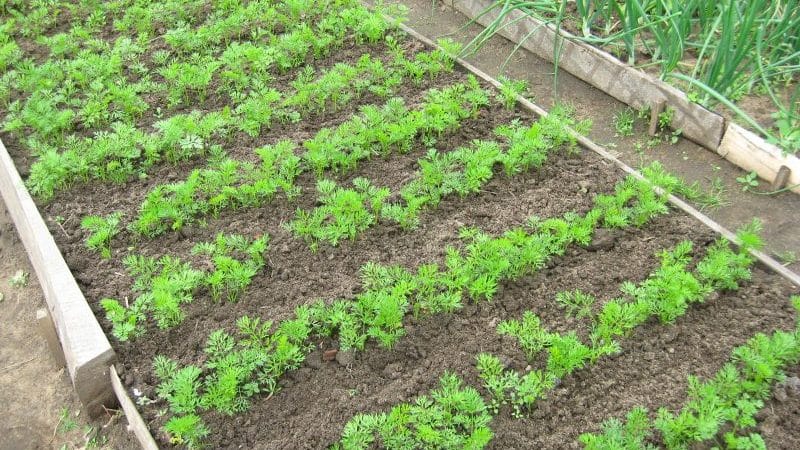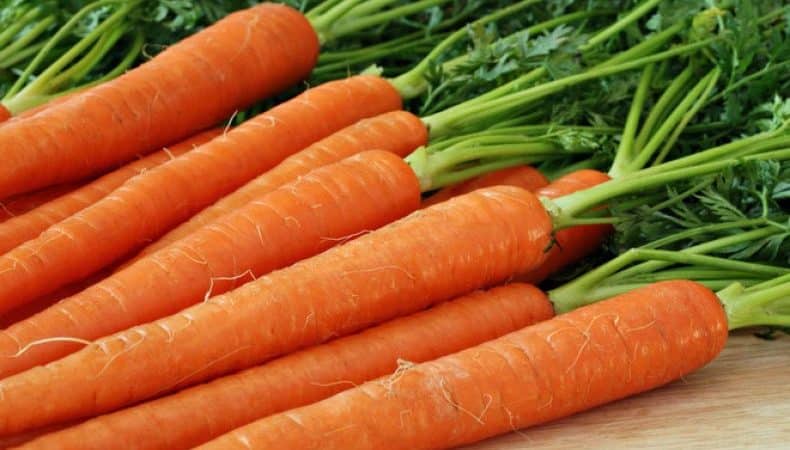Growing carrots in the middle zone: a review of the best varieties
Carrots are a tasty and healthy vegetable that every gardener grows on their plot. This is a universal product for salads, first and second courses.
Carrots are superior to other vegetables and fruits in carotene content. Need a source of vitamins, minerals and fiber? Plant carrots. We'll talk about how to do this correctly below.
Features of the climate of central Russia
Central Russia is an area with a temperate continental climate. Winter is characterized by moderate frosts and heavy snowfalls. Summers in the region are humid and relatively warm. Spring and autumn periods are pronounced.
March is still considered a winter month, when the snow melts. Dry and warm weather prevails in April and May. This helps the soil dry out. During this period, gardening work begins.
The middle zone is characterized by a long period of frost. They continue until the last days of May.
In the summer months, the maximum air temperature rises to +36-39°C, and sometimes there are droughts. The peculiarity of the summer period is moderately warm, humid and changeable weather.
Autumn begins in September with a gradual decrease in air temperature and increasing precipitation. The rainiest months of the year are October and November. The first snowfalls often occur in October. In November there may be constant rain or frost.
Winter in the region is long.The highest air humidity of the year occurs in December, so even in mild frosts it can be cold. The coldest month of the year is January, the snowiest month is February.
Technology and timing of planting carrots in the middle zone

In central Russia, carrots are planted in open ground in April and May. Focus on soil temperature - not lower than 4-6°C. Planting seeds in the southern regions is possible in early April, in the northern regions - in mid-May.
It is not recommended to plant carrot seeds in the same place more than once every 4 years, or after parsnips or celery. Favorable predecessors are tomatoes, potatoes, zucchini or cucumbers.
Carrots love loose loamy and sandy soil that is easily permeable. It is better if it is slightly acidic, with pH = 5-6. To obtain a rich harvest, you need fertile soil - the humus content makes it so. Its optimal concentration in soil for carrots is at least 4%. It is better to locate the bed in a place where the groundwater is deep and the soil moisture is kept moderate.
Another condition for carrot yield is good lighting. Before landing seeds, the soil is dug up, weeds are weeded and fertilizers are applied. Suitable compost or humus, bone meal, potassium sulfate, superphosphate. After applying fertilizer, the bed is dug up again to a depth of 20-30 cm and thoroughly loosened. Two weeks before sowing, it is loosened again.
To prevent diseases, a week before sowing, the bed is watered with Fitosporin and covered with film. Carrot seeds are planted in pre-made grooves 2-3 cm deep. The distance between them is at least 15-20 cm.
The finished grooves are first shed with a solution of Fitosporin.Experienced gardeners advise sprinkling them with tobacco dust or wood ash to repel them. pests.
Then the seeds are planted. The optimal distance between them is 2-3 cm. After planting, the seeds are covered with fertile soil and the soil in the furrows is slightly compacted. To make them germinate faster, the bed is covered with agrofibre. This will retain heat and moisture in the soil.
Important! 1-2 weeks after seed germination, the covering material is removed so that the sprouts do not rot under the film.
Carrots sown with sand. To do this, mix ½ bucket of dry river sand and 2 tbsp. l. seeds The resulting mixture is scattered into the furrows, covered with a small layer of soil and watered.
Another way to plant carrots is on paper tape. Cut strips of thin paper or use regular toilet paper. First, prepare the paste: add 1 tsp to boiling water. starch for 1 tbsp. water. Stir and cool.
Place a paper strip at the bottom of the grooves, smear it with paste and place carrot seeds on it at a distance of 3-4 cm from each other. The furrows are covered with soil and watered abundantly.
What is the difference between carrots for the middle zone

Since the climate of central Russia is moderately warm, special attention is paid to the choice of carrot varieties. They must be productive and resistant to low temperatures.
It is better to do thinning later. If you take out the first root crops already in July, then the tap root of the neighboring ones may break off. At this time, the mass increases and the risk of branching increases. As a result, when harvesting, a large percentage of branched root crops come out.
Early harvesting of carrots in the middle zone is not recommended. At the beginning of September, the main increase in the mass of root crops occurs, so it is better to postpone harvesting until the end of the month.
The best varieties of carrots for the middle zone
All varieties of carrots are divided into two types according to the shape of the root crop: cylindrical and cone-shaped with a narrowing towards the bottom. Varieties also differ in color: from yellow and orange to purple.
Most varieties of carrots for growing in the middle zone are characterized by high yield and taste. The geographical area allows for the cultivation of early, late and mid-season varieties.
Early
Early varieties ripen 85-100 days after emergence. The most popular of them:
- Carotel Parisian. The earliest ripening variety. The root crops are short, orange, and round-ovoid in shape.
- Dragon. The color of the root vegetables is bright purple, the core is orange. They have a specific odor that disappears after heat treatment.
- Lagoon F1. Hybrid with the earliest ripeness. The maximum weight of root vegetables is 200 g. The color is bright orange, the shape is cylindrical.
- Fairy. Universal early ripening variety. Root vegetables are cylindrical. Good for winter storage.
- Bangor F1. It has narrow, long root vegetables weighing up to 200 g. It is well stored in winter.
Carrots dug out of damp soil must be thoroughly dried, otherwise the shelf life will be shortened.
Mid-season
The ripening period of mid-season varieties is from 105 to 120 days.
The best mid-season varieties:
- Viking. A variety with a high carotene content. The root vegetable has a conical shape, it has juicy, tender pulp. The variety has good keeping quality.
- Losinoostrovskaya 13. High-yielding variety with high carotene content. Root vegetables are cylindrical in shape, with red-orange pulp.
- Nantes 4. The most popular carrot variety in Russia with excellent taste. The shape of the root vegetables is cylindrical, the flesh is red-orange.Stores well until mid-winter.
- Nectar F1. High-yielding hybrid with long cylindrical roots that are resistant to cracking. They have a bright orange color and a sweet taste.
- Moscow winter. A common, productive, long-storage variety that lasts well until spring. Root vegetables are conical, juicy, with a sweet taste.
Late
Late varieties ripen in 125 days or more.
Fruitful late varieties:
- Selecta. A variety with a high carotene content. It has cylindrical root crops up to 15 cm long.
- Vita longa. Root vegetables are juicy and sweet and contain a lot of carotene. Suitable for juice production.
- Olympus. A common high-yielding variety. Root vegetables are juicy, sweet, and stored until spring.
- Valeria 5. It has conical long roots with a yellow core and red flesh. Gives a good harvest.
Carrot varieties with a high carotene content are suitable for baby food.
Reviews of the best varieties in Russia

Experienced gardeners choose the best varieties and willingly share their opinions.
Gennady, Tula: «I would recommend Nantes carrots to anyone. It lasts well until spring, does not become flabby or spoil. The variety is unpretentious and grows well. When we salt cabbage, we don’t add sugar, because with these carrots it’s not needed.”
Valentina, Vologda: “I plant several varieties of carrots every year and like to experiment. But I always plant the Karotel variety, as it gives an excellent harvest. We love fresh shredded carrots, and Karotel is sweet and juicy.”
Natalya, Rybinsk: “I plant late varieties of carrots, they are very juicy. My favorite variety is Olympus. I always collect a lot of strong, good carrots. We have enough harvest until spring, and the carrots remain juicy.”
Conclusion
The climate of central Russia makes it possible to grow early, mid-season and late varieties. When choosing, pay attention to yield, shelf life, and vitamin content. If you follow the growing rules, any of the varieties will delight you with a bountiful harvest and will retain its qualities during long-term storage.